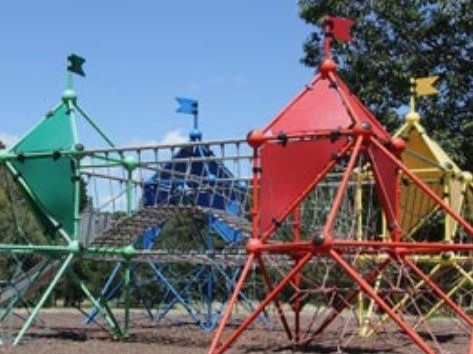Play spaces map
| Legend | |||
|---|---|---|---|
|
|
District | Neighbourhood | |
|
|
Community | Natural neighbourhood |
District
WHAT: District play spaces provide play and outdoor recreation facilities for a large part of Canberra, catering to a significant number of children and their families, and offer the greatest number of play experiences and amenities for a wide range of users.
Facilities are designed with multiple play areas that cater to different age groups. They will generally include structured play equipment, nature play, open space, barbeques, picnic shelters, toilets, car parks, and landscaped areas to encourage large group gatherings and longer visits.
District play spaces are the kind of facilities that families may make a dedicated outing to on the weekend, making them a ‘destination’ play space.
WHERE: Under the strategy there should be at least one district play space per district, once these reach a significant population size. This recognises that community infrastructure is generally delivered over time in new parts of Canberra as districts are developed. These play spaces are often located in district parks with features such as higher-level sporting facilities, lakes, rivers or nature reserves.
WHO: District play spaces aim to meet the needs of toddlers (0-4), juniors (5-9), pre-teens (10-13), teenagers (14-17) and adults.

Central
WHAT: Central play spaces can be found throughout a district and function as community hubs. Central play spaces are often located near community facilities, sports fields, parks or suburban shopping centres. Preferably they are well connected to pedestrian and cycle networks for accessibility.
These play spaces provide a diverse range of equipment and amenity with play experiences including nature play, traditional play and open space. Amenities include path access, seating and/or picnic shelters, shade and drinking fountains. Central play spaces are the kind of spaces that families may visit alongside of other activities, such as visiting their local shops, playing sport or meeting with friends after school.
WHERE: Ideally, there is one central play space per two or three suburbs. However, this depends on the availability of suitable space and community facilities, as well as geographic size and population of the suburbs.
WHO: Central play spaces aim to address the needs of toddlers (0-4), juniors (5-9) and pre-teens (10-13).

Neighbourhood
WHAT: Neighbourhood play spaces can be found within close proximity to homes. These play spaces contain basic structured play equipment, nature play – or a mix of both. They also feature core amenities such as seating, and open space within a park setting.
These are the kinds of play spaces that families with small children may visit multiple times a week to spend time outdoors and get active during early developmental years.
WHERE: Ideally every residential area should have a local park or play space within approximately 10-15 minutes’ walk of most residences.
WHO: These play spaces cater to toddler (0-4) and junior (5-9) age groups.

Top 10
Top 10 play spaces
1. Boundless Playground, Parkes (NCA)
2. Pod Playground, National Arboretum
3. John Knight Memorial Park, Belconnen
4. Kambah Adventure Playground, Kambah
5. Weston Park, Yarralumla
6. Community Recreation Park, Moncrieff
7. Yerrabi Pond District Park, Gungahlin
8. Fadden Pines, Fadden
9. Chifley Shops Playground, Chifley
10. Black Mountain Peninsula Park, Acton
















